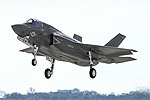Marines' F-35B preps for air wars during major combat exercise
 The Marine Corps’ F-35B is taking part in the Air Force’s premier air-to-air combat training exercise for the first time ever.
The Marine Corps’ F-35B is taking part in the Air Force’s premier air-to-air combat training exercise for the first time ever.
The joint strike fighters from Marine Fighter Attack Squadron 121 are participating in Exercise Red Flag, which began on July 11 and runs until July 29 at Nellis Air Force Base, Nevada.
During the training event, Marine Corps and Air Force pilots will go up against the most sophisticated enemy aircraft, air defense systems and cyber threats that they would encounter if the U.S. went to war with a near-peer rival.
The simulated aerial engagements at Red Flag will focus on flight safety and finding the best uses for all the tools available to pilots rather than three-dimensional maneuvering, said 2nd Lt. Casey Littesy, a spokeswoman for the 3rd Marine Aircraft Wing. The F-35's long-range sensors and weapons make it unlikely that the aircraft will have to engage in within visual-range air-to-air combat, she said.
“It is always possible that the F-35B could face a situation that puts it in visual range; therefore, pilots must continue to train to maneuver the jet at the edges of its operational envelope in order to obtain a positional advantage,” Littesy said.
Ultimately, the Marine Corps plans to purchase 353 F-35Bs, and 67 F-35Cs, which have tail hooks that allow them to land on aircraft carrier. The 420 aircraft will replace the Marine Corps' aging F/A-18 Hornets, EA-6B Prowlers and AV-8B Harrier II jets by fiscal 2032.
The Marine Corps' variant of the F-35 can take off and land vertically, allowing it to operate from much smaller runways than other aircraft. At recent airshows in Britain, the F-35B demonstrated how it can come to a dead stop in mid-air and hover to the ground.
The F-35B’s participation in Red Flag is a major step forward for the program, said Jesse Sloman, an analyst for the Center for Strategic and Budgetary Assessments think tank in Washington.
Although F-35Bs have flown the Marine Corps Weapons and Tactics Instructors course, the equivalent of the Navy’s TOPGUN school, Red Flag includes a wider variety of missions, Sloman said.
One drawback the F-35B continues to deal with is that the planes are still using the interim Block 2B software, which limits the aircraft’s sensors and restricts the weapons it can carry to AIM-120 missiles and certain laser- and GPS-guided bombs, he said.
“The Corps is scheduled to upgrade the F-35B to its full warfighting capability in 2017 with the introduction of the Block 3F software, which will expand the aircraft's weapons, sensor, and avionics capabilities,” Sloman said. “Until that occurs, Marine F-35s will be severely limited in the missions they can perform."
But Guy Vallhonrat, the F-35B program manager for headquarters Marine Corps aviation, said the aircraft can already conduct every operational mission that the Marine Corps’ Hornets and Harriers are flying today. Marine pilots have called the F-35B the best tactical aircraft they’ve ever flown, adding they did not want to go back to flying older aircraft.
“It is true that 3F the capabilities of the aircraft will expand significantly, and the Marine Corps is looking forward to expanding the scope and numbers of missions available,” Vallhonrat said.